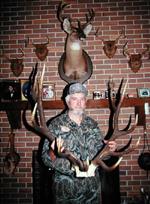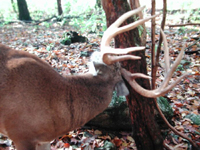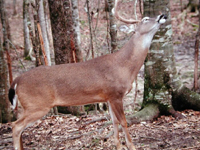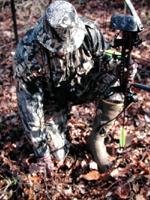
|
Features
|
|
|
|
Books
|
|
|
|
Fun & Games
|
|
|
|
Contact Us
|
|
|
John's Journal... Entry 116, Day 1
WHEN DEER DON'T SHOW UP AT DEER SIGN
Read the Fine Print of Deer Sign
 EDITOR'S
NOTE: Deer sign sometimes lies to hunters. If you could trust all
deer sign, you'd bag a buck near every deer sign you find in the woods.
But how do you know when deer sign lies and when it tells the truth? How
can you tell if the deer has made the sign during the day or the night,
today or three weeks ago? To hunt deer successfully, you must not only
find deer sign -- you must interpret correctly what that sign tells you.
EDITOR'S
NOTE: Deer sign sometimes lies to hunters. If you could trust all
deer sign, you'd bag a buck near every deer sign you find in the woods.
But how do you know when deer sign lies and when it tells the truth? How
can you tell if the deer has made the sign during the day or the night,
today or three weeks ago? To hunt deer successfully, you must not only
find deer sign -- you must interpret correctly what that sign tells you.
One of the nation's best bowhunters, Jerry Simmons of Jasper, Alabama, serves as president of Simmons Broadhead Company and a member of the Mossy Oak Hunting Team. If you had to bet money on any archer taking a deer with his bow anywhere in the nation, choose Simmons. He wins hands-down over almost every bowhunter for finding, reading and interpreting deer sign. But even Simmons sometimes gets stumped.
 "Once
I was hunting a wildlife-management area when I found an acorn tree on
which the deer were feeding," Simmons recalls. "This spot had
all the right signs. Three different trails converged at the tree, and
I saw fresh deer droppings at the site. Too, empty acorn hulls indicated
that the deer were feeding there. I noticed plenty of acorns on the ground
that the deer could continue eating, and from all indications I thought
this place would be an easy spot to take a deer. However, after hunting
this feeding site for three consecutive mornings, I still never saw a
deer." Simmons decided the deer must have fed in the afternoons under
this tree, because he found fresh sign there every day, even when he didn't
see deer. But then he spent two afternoons hunting this site without spotting
a deer. Although frustrated by this lying sign, Simmons still believed
he'd locate deer feeding there and would arrow a buck at this site.
"Once
I was hunting a wildlife-management area when I found an acorn tree on
which the deer were feeding," Simmons recalls. "This spot had
all the right signs. Three different trails converged at the tree, and
I saw fresh deer droppings at the site. Too, empty acorn hulls indicated
that the deer were feeding there. I noticed plenty of acorns on the ground
that the deer could continue eating, and from all indications I thought
this place would be an easy spot to take a deer. However, after hunting
this feeding site for three consecutive mornings, I still never saw a
deer." Simmons decided the deer must have fed in the afternoons under
this tree, because he found fresh sign there every day, even when he didn't
see deer. But then he spent two afternoons hunting this site without spotting
a deer. Although frustrated by this lying sign, Simmons still believed
he'd locate deer feeding there and would arrow a buck at this site.
 "I
decided that if the deer were coming to that tree during daylight hours,
I was going to see those deer," Simmons explains. "I packed
a lunch and other supplies, climbed into a tree before daylight and resolved
to stay until black-dark. At 11:45 a.m. I saw the first doe appear and
then several more. At 12:15 p.m. a nice buck moved into the feeding area
and turned broadside to me. I drew and released my arrow and finally took
a buck." Apparently, the deer had learned they would experience the
least amount of hunting pressure in the middle of the day when most hunters
had left the woods to eat lunch and only felt comfortable feeding under
the oaks in the middle of the day.
"I
decided that if the deer were coming to that tree during daylight hours,
I was going to see those deer," Simmons explains. "I packed
a lunch and other supplies, climbed into a tree before daylight and resolved
to stay until black-dark. At 11:45 a.m. I saw the first doe appear and
then several more. At 12:15 p.m. a nice buck moved into the feeding area
and turned broadside to me. I drew and released my arrow and finally took
a buck." Apparently, the deer had learned they would experience the
least amount of hunting pressure in the middle of the day when most hunters
had left the woods to eat lunch and only felt comfortable feeding under
the oaks in the middle of the day.
 Many
hunters overlook the importance of pinpointing the time when deer feed
at a feeding site that exhibits plenty of sign. Deer normally come to
food early in the morning or late in the evening. But when pressure causes
them to stay in cover early and late, often deer will feed in the middle
of the day. "Since I learned this lesson many years ago, I've been
able to take several nice bucks on public land by bowhunting in the middle
of the day," Simmons emphasizes. Oftentimes the fine print on deer
sign should read, "Consider other factors that aren't visible when
reading deer sign." Weather conditions, hunting pressure, buck fights,
coyote attacks and dogs running through an area all influence deer sign.
Factors such as these can keep deer sign from revealing all the information
a hunter needs to know to make a decision about when and where deer probably
will show up.
Many
hunters overlook the importance of pinpointing the time when deer feed
at a feeding site that exhibits plenty of sign. Deer normally come to
food early in the morning or late in the evening. But when pressure causes
them to stay in cover early and late, often deer will feed in the middle
of the day. "Since I learned this lesson many years ago, I've been
able to take several nice bucks on public land by bowhunting in the middle
of the day," Simmons emphasizes. Oftentimes the fine print on deer
sign should read, "Consider other factors that aren't visible when
reading deer sign." Weather conditions, hunting pressure, buck fights,
coyote attacks and dogs running through an area all influence deer sign.
Factors such as these can keep deer sign from revealing all the information
a hunter needs to know to make a decision about when and where deer probably
will show up.
TOMORROW: HUNT FOR THE INVISIBLE BUCK
Check back each day this week for more about Deer Sign...
Day 1 - Read the Fine Print
of Deer Sign
Day 2 - Hunt for the Invisible Buck
Day 3 - Learn Why the Sign Lies
Day 4 - Find the Sign Least Likely to Lie
Day 5 - Understand That Deer Sign is Like
a History Book